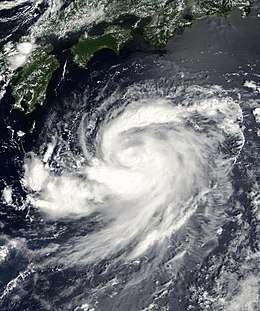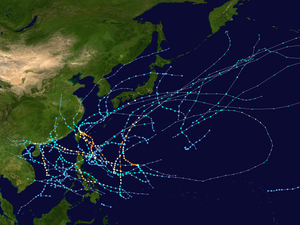Tropical Storm Vongfong (2008)
Severe Tropical Storm Vongfong was the 12th tropical depression and the 11th tropical storm of the 2008 Pacific typhoon season recognised by both the JMA and the JTWC. Vongfong was a severe tropical storm that was active in August 2008. Vongfong originally formed on August 14 as a tropical depression to the south of Japan. The next morning Vongfong was upgraded to a tropical storm by both the JMA and the JTWC and then reached its peak intensity early the next morning and became extratropical at that strength early on August 18.
| Severe tropical storm (JMA scale) | |
|---|---|
| Tropical storm (SSHWS) | |
 Vongfong shortly before being named on August 15 | |
| Formed | August 14, 2008 |
| Dissipated | August 19, 2008 |
| (Extratropical after August 17, 2008) | |
| Highest winds | 10-minute sustained: 95 km/h (60 mph) 1-minute sustained: 100 km/h (65 mph) |
| Lowest pressure | 990 hPa (mbar); 29.23 inHg |
| Fatalities | 1 direct |
| Damage | Minimal |
| Areas affected | Japan |
| Part of the 2008 Pacific typhoon season | |
Meteorological history

Early on August 13, the Joint Typhoon Warning Center, noted that an area of convection had persisted approximately 370 nautical miles (690 km) to the southeast of Okinawa, Japan and designated it as a Tropical Disturbance.[1] The JTWC at this time also assessed the disturbances chances of forming into a significant tropical cyclone within 24 hours as fair.[1] This was due to the tropical disturbance having a broad Low Level Circulation Center however the strongest winds were displaced on the eastern side of the disturbance.[1] Early the next morning the JTWC reassessed the disturbances chances of forming into a significant tropical cyclone within 24 hours as good and issued a Tropical Cyclone Formation Alert on the developing disturbance.[2] This was because the Low Level Circulation Center had become well defined.[2]
Later on August 14, the Japan Meteorological Agency designated the tropical disturbance as a minor tropical depression whilst the JTWC also upgraded the disturbance and designated it as Tropical Depression 12W.[3][4] Early the next day the JMA designated the depression as a full tropical depression, whilst the JTWC upgraded the depression to a tropical storm.[5][6] Later that day the JMA upgraded the depression to a tropical storm, and assigned the name Vongfong to the storm.[7] The Joint Typhoon Warning Center then reported that Vongfong had reached its peak winds of 50 knots (60 mph, 95 km/h1-Min) whilst it was located approximately 390 nautical miles (720 km) to the southwest of Tokyo, Japan.[8] The JMA also then reported that it Vongfong had reached its operational peak winds of 40 knots (45 mph 75 km/h 10-Min) however this was later revised in its best track when the JMA upgraded Vongfong peak winds to 50 knots (60 mph 110 km/h 10-Min).[9][10] Later on August 15, the JTWC reported that Vongfong had started to weaken from its peak.[11] During the next day Vongfong carried on weakening. The JTWC then issued its final warning on Vongfong later that day as it had begun its extratropical transition.[12] whilst the JMA kept issuing warnings on Vongfong until early on August 17 when they downgraded it to an extratropical low.[13] The extratropical low of Vongfong then crossed the International Dateline and moved out of the JMA's area of responsibility and moved into the Central Pacific Hurricane Center's area of responsibility but they did not issue any warnings on Vongfong as it was extratropical.[10]
Impact and naming
As Vongfong brushed by Japan, heavy rains triggered flood which killed one person. A total of 523 homes and 39 hectares (96.3 acres) were damaged by the storm and 15,520 people were left without power. The storm also damaged 139 roads and caused 54 landslides.[14]
The name "Vongfong" was one of the 10 original names submitted by Macau to the WMO's Typhoon Committee for use from January 1, 2000.[15] Vongfong was last used in the 2002 Pacific typhoon season and is the Macau word for wasp.[16]
See also
References
- "Tropical Weather Summary 13-08-2008 06z". Joint Typhoon Warning Center. Retrieved 2008-11-03.
- "Tropical Cyclone Formation Alert 14-08-2008 00z". Joint Typhoon Warning Center. Retrieved 2008-11-03.
- "JMA Advisory 14-08-08 18z". Japan Meteorological Agency. Retrieved 2008-11-20.
- "JTWC Warning 14-08-08 21z". Joint Typhoon Warning Center. Retrieved 2008-11-03.
- "JMA Advisory 15-08-08 00z". Japan Meteorological Agency. Archived from the original on 2008-08-15. Retrieved 2008-11-23.
- "JTWC Warning 15-08-08 03z". Joint Typhoon Warning Center. Retrieved 2008-11-03.
- "JMA Advisory 15-08-08 06z". Japan Meteorological Agency. Archived from the original on 2008-08-15. Retrieved 2008-11-23.
- "JTWC Warning 15-08-08 09z". Joint Typhoon Warning Center. Retrieved 2008-11-03.
- "JMA Advisory 15-08-08 12z". Japan Meteorological Agency. Archived from the original on 2008-08-15. Retrieved 2008-11-23.
- "JMA Best Track:Vongfong". Japan Meteorological Agency. Archived from the original on 2008-08-17. Retrieved 2008-11-23.
- "JTWC Warning 15-08-08 15z". Joint Typhoon Warning Center. Retrieved 2008-11-03.
- "JTWC Warning 15-08-08 15z". Joint Typhoon Warning Center. Retrieved 2008-11-03.
- "JMA Advisory 17-08-08 06z". Japan Meteorological Agency. Archived from the original on 2008-08-17. Retrieved 2008-11-23.
- "41st Session Country Report: Japan" (PDF). World Meteorological Organization. Retrieved 2009-01-09.
- "Tropical Cyclone Names in 2000–2001". Hong Kong Observatory. 2000. Retrieved 2008-09-26.
- "The meaning of tropical cyclone names". Hong Kong Observatory. 2008. Retrieved 2008-09-26.
External links
| Wikimedia Commons has media related to Tropical Storm Vongfong (2008). |
- JMA General Information of Severe Tropical Storm Vongfong (0811) from Digital Typhoon
- JMA Best Track Data of Severe Tropical Storm Vongfong (0811) (in Japanese)
- JMA Best Track Data (Graphics) of Tropical Storm Vongfong (0811)
- JMA Best Track Data (Text)
- JTWC Best Track Data of Tropical Storm 12W (Vongfong)
- 12W.VONGFONG from the U.S. Naval Research Laboratory
